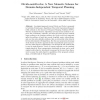110
Voted
JAIR
2006
15 years 16 days ago
2006
In this paper, we present the partitioning of mutual-exclusion (mutex) constraints in temporal planning problems and its implementation in the SGPlan4 planner. Based on the strong...
98
Voted
AIPS
2009
15 years 1 months ago
2009
Planning systems for real-world applications need the ability to handle concurrency and numeric fluents. Nevertheless, the predominant approach to cope with concurrency followed b...
109
click to vote
AIPS
2009
15 years 1 months ago
2009
PDDL2.1 supports modelling of complex temporal planning domains in which solutions must exploit concurrency. Few existing temporal planners can solve problems that require concurr...
IJCAI
2003
15 years 1 months ago
2003
Graphplan planning graphs are structures widely used in modern planners. The exclusion relations calculated in the planning graph extension provide very useful information, especi...
87
Voted
AIPS
2007
15 years 2 months ago
2007
The last eight years have seen dramatic progress in temporal planning as highlighted by the temporal track in the last three International Planning Competitions (IPC). However, ou...
108
click to vote
AIPS
2007
15 years 2 months ago
2007
Due to its important practical applications, temporal planning is of great research interest in artificial intelligence. Yet most of the work in this area so far is limited in at...
109
click to vote
AAAI
2008
15 years 2 months ago
2008
We present the first planner capable of reasoning with both the full semantics of PDDL2.1 (level 3) temporal planning and with numeric resources. Our planner, CRIKEY3, employs heu...
97
Voted
EVOW
2006
Springer
15 years 4 months ago
2006
Springer
An original approach, termed Divide-and-Evolve is proposed to hybridize Evolutionary Algorithms (EAs) with Operational Research (OR) methods in the domain of Temporal Planning Prob...
92
Voted
EPIA
2001
Springer
15 years 5 months ago
2001
Springer
Dealing with temporality on actions presents an important challenge to AI planning. Unlike Graphplan-based planners which alternate levels of propositions and actions in a regular ...
116
Voted
ICTAI
2002
IEEE
15 years 5 months ago
2002
IEEE
(Appears as a regular paper in the proceedings of IEEE International Conference on Tools with Artificial Intelligence (ICTAI), IEEE Computer Society, Washington D.C. Nov. 2002, p...



